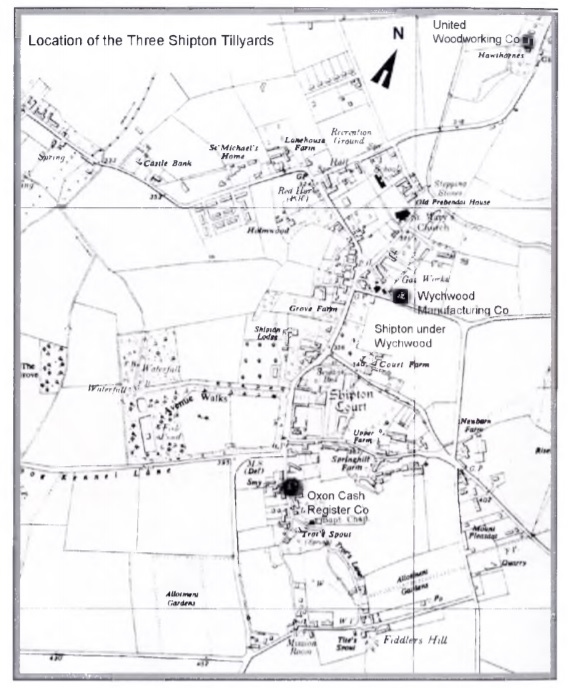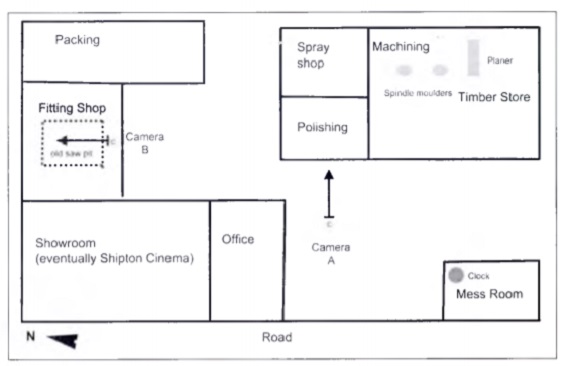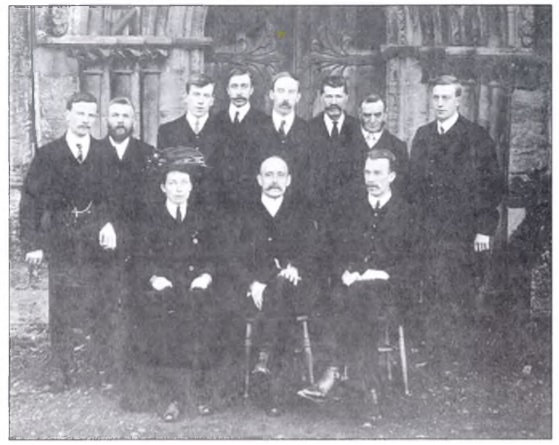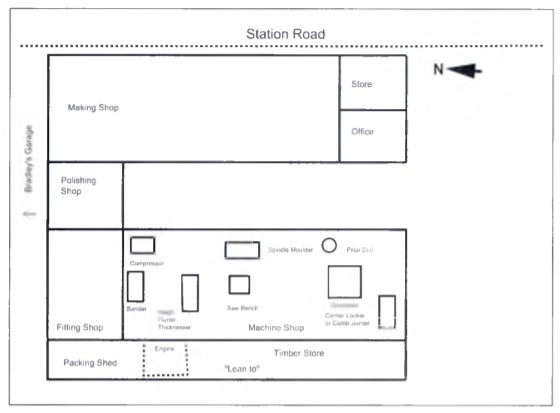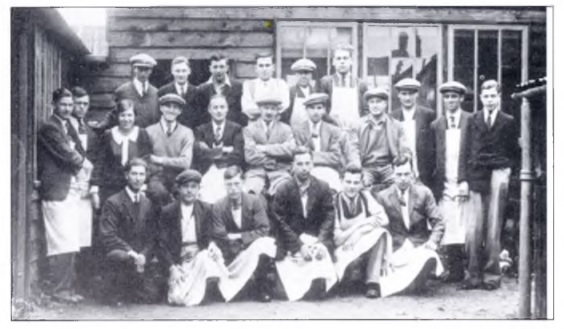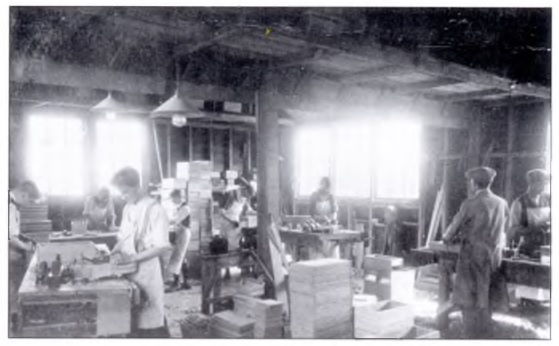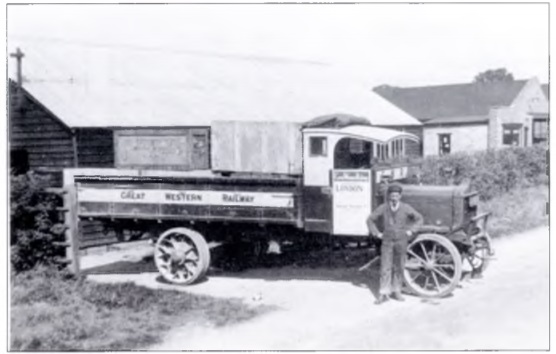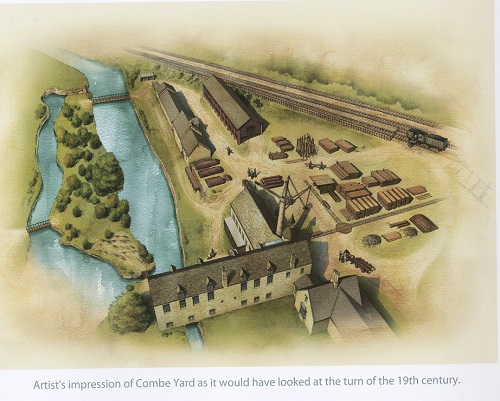The following article by Alan Vickers is based on the written notes of Jeff Broxholme, who has lived at Milton under Wychwood since 1969.
An idyllic Life –
Living by an old Oxfordshire Mill before and during the Second World War
His family lived very simply but Jeff Broxholme still remembers his early life at Combe Mill with affection. Combe Mill is in a valley midway between Long Hanborough and Combe Village in West Oxfordshire. The Oxford Worcester railway shares this valley with the River Evenlode. Combe Mill is mentioned in the Doomsday Book but was probably not as large as it is today. It is assumed that this earlier mill was a flour mill, powered by a water wheel on the River Evenlode. It has greatly changed since that time. Even the original village has disappeared, possibly because of the Black Death. It is said to have been relocated to the top of the hill where the present village stands, about one mile North of Combe Mill. There are no remains of the original village except for a mound where the church stood. This is on the left near the top of the drive from the road linking Long Hanborough with Combe.
The
drive itself leads to the Blenheim Estate Maintenance Yard. It passes two
cottages where Jeff Broxholme lived until he was eighteen years old. Part of
the first building on the left was a saw mill, in use until around 1980.
His
father, Stephen Leonard Broxholme (always known as Leonard) was born in Ragby
Lincolnshire in 1901. He worked as a sawyer in the local sawmill until 1927 and
then moved to Heythrop to work in the sawmill there. In 1930 he married the
housekeeper and cook of the Rectory at Cornwell, Emily Selina Hands from
Chipping Norton and needed a house for his new family. He found a position as
manager of the sawmill on an old estate yard belonging to the Duke of
Marlborough in Combe and moved there in 1931. Jeff was born in the same year
and his sister Edith Marina followed in 1934. Jeff’s father was the only sawyer
at the mill which was very run down following the First World War and the
depression of the 1920s. He was to work there from 1931-1949 cutting timber
from the Estate Woods for use on the Estate – planks, posts, rails and oak
coffin boards for Blenheim Palace.
Early Life
Jeff’s early life was somewhat precarious. At first the family lived in a small thatched cottage in the hamlet of East End Combe. When he was only two, a beam above the cottage fireplace caught fire which spread to the thatch. He still recalls the flames and reflections off the firemens’ helmets. He was taken to another house in the hamlet. His mother was rehoused with a friend nearby. Shortly afterwards the family moved to Combe Mill. There he suffered a series of illnesses, possibly due to the poor water quality at the Mill. At first he developed a large swelling in the neck and had this operated on at the Radcliffe, travelling there from the new railway halt at Combe. While recuperating he took some water to drink from a bucket at Mrs Williams’, friends of his parents who had helped them following the fire. He slipped and fell on the edge of the bucket undoing all his stitches. Somebody with a car took him back to the Radcliffe. Later he spent time in the isolation ward at Abingdon with scarlet fever.
Life at Combe Mill
Food
was never in short supply. Leonard always had a fried breakfast before going to
work. Eggs came from their own chickens. A very impressive cockerel attacked
young Jeff but disappeared very shortly afterwards, presumably via the pot. Rabbits
and hares could be caught but game birds belonging to the Estate were strictly
off the menu (hardly surprising when a gamekeeper was summarily dismissed after
a day’s shoot just failed to reach a bag of one thousand birds!).
Occasionally
there were shooting parties from the Estate in the vicinity of the Mill and
Jeff’s home would be used for luncheon if required. The servants brought the
food in hay boxes. The ladies used the house for powdering their noses – how
they got on with the Elsan earth toilet in the garden is not known!
There were domestic rabbits too whose numbers
were increased by taking the does to the buck in Long Hanborough. Two pigs were
kept in sties at the back of the house. One was killed in March and one in
November by the local slaughter man. A straw fire would be lit to burn off the
bristles and the carcase hung up to bleed. Milk was delivered from Richard
Colliers’s farm along the lane. Although the river was close by, fresh fish did
not figure on the menu although occasionally eels were caught and eaten and
their skins used for shoe laces. In season, blackberries and hazelnuts could be
gathered from the hedgerows close to the mill.
Bread
and meat were delivered. The meat came from a butcher in Woodstock. Bread was
supplied by the two bakers in Combe. One,
Mr Pott, did not have a van and walked everywhere with a large basket. He also
delivered telegrams and cooked meat for private households on Sundays. The Coop could be reached by bicycle to Long
Hanborough. Some groceries came in Walford’s van from Bladon and there was a
small grocers in Combe, Teddy Busby Stores. The Combe Post Office also served
as a general store. Brookes stores, also in Combe, supplied sweets. Clothes
were ordered at Strong and Morris in Woodstock but sometimes items were
obtained from Banbury.
Mrs
Broxholme made a wheat and potato wine. Other sources of alcoholic beverages
were the three public houses which existed at that time in Combe village – the
Cock (still in existence today), the Royal Oak and the Marlborough Arms. The
Royal Oak suffered a setback when the landlord, Mr Muggeridge, killed himself
by jumping off a railway bridge into the river following irregularities with
the Christmas fund.
Heating
the home was not a problem as the family could burn the offcuts from the sawmill.
The same energy supply served for cooking. Electric power only came to the
cottage in the 1950s. Light was from paraffin lamps or candles.
Entertainment
was from a battery powered radio bought just before the War and attached to a
long wire aerial. New batteries were sourced from Woodstock when required.
There were no holidays but only the occasional bus trip to the coast, mostly to
Southsea which was the closest point on the coast. A train trip to Chipping
Norton to visit his maternal grandparents was an infrequent pleasure. This
would be either in a diesel car or on a steam train where the driver would
sometimes allow you to stand on the footplate. At Kingham one had to change and
go over the covered bridge to catch the train to Chippy.
School Life
Jeff started his formal education at five years old in the infant department of Combe School. He would be taken the one and half miles on the back of a bicycle ridden by his mother. Because of the earlier injury to his neck, he was always reminded to take extra care and could not take part in sports or games so that he felt isolated from his schoolmates. There was no hot food at school. Most children went home at midday. Some, like Jeff, who lived some distance from the village, were allowed to stay in the school and eat their sandwiches. A large white card was hung on the school gate and the children could not re-enter the school until this was removed. Jeff would be picked up again by his mother at the end of school. In the meantime, his father kept an eye on Edith, sometimes with the help of a neighbour, until his mother got back.
The
School comprised two classes and served around 35 pupils. Mrs Woodward looked
after the infants (aged 5 to 7). Jeff was one of the smallest children and was
put next to another small boy, Derek Allan, at the front of the class. Next
door, the Head teacher, Miss Walker, had four different classes in one room – 7
to 8 year olds, 8 to 9 year olds, 9 to 10 year olds and 10 to 11 year olds.
The
ultimate disciplinary sanction was the cane across the hand. Jeff remembers the
cane breaking on the hand of a boy called David Oliver.
At
the age of eleven, those, who had passed the Scholarship, went to Chipping
Norton Grammar School. They cycled to Stonesfield (on bicycles apparently
provided by the Council) where they caught a bus. Jeff went instead to the
Marlborough Secondary Modern School at Woodstock. Prior to this school being
opened in 1939, village children who did not pass the 11+ went by bus to the
bigger school in Church Handborough.
The
keepers saw to it that there were no raptors in the neighbourhood but Jeff
remembers other wild life – otter spraints on the concrete strip near the mill,
water voles and lots of hedgehogs. Strangely he does not recall seeing wild
ducks but one year there was a wild goose down by the river although this
disappeared just four days before Christmas!
The Village Calendar
An
important village event was the celebration of Mayday. All the school pupils
were taught various dances. The older girls had to decorate an old bath chair
with flowers to form a suitable carriage for the May Queen, chosen, along with
a May King, by the Head teacher, Miss Walker. This carriage was pulled around
the village and a collection made for some unspecified purpose. The girls wore
flower patterned dresses with bonnets. The boys had hoods extending over their
shoulders in green cotton and long green buttoned coats reaching nearly down to
their knees. Costumes were made by Miss Walker’s mother who lived with her in
the school house. After the dancing on the green, there was a tea party and
sports.
The
first Sunday after 10th August was the Combe Feast. There was a
funfair often with steam engines, on both village greens.
There
were other flower and vegetable shows, which were usually held in conjunction
with a fete and sports. These took place either at “Combe House” or at Mrs
Cottrel Dormer’s in the middle of the village. Jeff’s father won many prizes
for his vegetables and Jeff and his sister usually won certificates for wild
flower displays.
At
the end of the school year, there was always a school play where Miss Walker
attempted to involve every child.
The Second World War
At
Sunday school one day, Jeff learned that “there was a war on”. When he got
home, his father confirmed this. Jeff asked who he was going to join, “the
cowboys or the indians”!
With
the outbreak of war the pupils were told to stick brown tape to the larger
windows of the School. They were issued with a gasmask at home. This was a
trunk like contraption with an eyepiece to look out from. The lower part
comprised a flat metal attachment which was adjusted by the man who had brought
it. The whole thing smelt strongly of rubber. Later everybody had to go to The
Royal Oak Public House and line up by a large table to have another bit fitted
to their gas mask. The lower part was green and it was fitted by means of some
special sticky tape. Apparently this new bit contained charcoal. Gasmasks were
kept in a brown cardboard box with a string handle so that they could be
carried over the shoulder. This later wore out so a tin tube with a lid and
string handle had to be bought to replace it. There were frequent practices at
school in putting on the gas mask. Sometimes the eye piece misted up and the
Head teacher told the children to rub some soap on the inside of the mask.
Great fun could be had by blowing effective raspberries from inside the mask.
There was no explanation as to what the brown paper or the gas masks were for.
Similarly the children did not know why they were asked to bring cans to school
and then hammer them flat.
Many evacuees came to Combe and the
surrounding area. They brought their own school teachers. One day two ladies
appeared at the Mill with five children from Enfield in tow. The Broxholme
family were required to house them – the French family of three (two girls,
Betty and Ruth and one boy Derrick) and one boy (Peter) and one girl (Beryl) from
a family called Carr. Peter and Derrick took the bus each day from Combe to
Marlborough School with Jeff. This unexpected supply of playmates was welcome
to Jeff and he does not recall any special friction between the children. They
delighted in playing in the surrounding woods and there were Leonard’s
wonderful sledges to play on in the winter.
Canadian
soldiers were billeted at Blenheim Park where cattle and some lambs were said
to have ended up on barbecues. The Americans were based at Brize Norton and
Heythrop and consequently black troops were a rare sight in Combe. There were
few British camps close to Combe apart from one at Finstock (the concrete
remains are still visible close to the Garden Centre.) Freeland housed a
military hospital.. There was a satellite airfield at Kingswood where Spitfires
were hidden in the woods.
In
the direction of Charlbury, there was a grass strip and a tin hangar housing a
Liberator for the personal use of Winston Churchill who was a frequent visitor
to Ditchley House.
Actual
military activity was hardly in evidence
– a few incendiary bombs falling on Stonesfield and Bladon and a Bren Gun
Carrier which became stuck in the river close to the Mill. The four Coldstream
guardsmen from the Bren Carrier spend six weeks living in the Mill yard
stables. Jeff and the evacuees helped clean the river mud off the bullets. His
mother did all their cooking and even interceded for them when their officer
would not let them go to a local dance!
The
closest form of military power was the Home Guard. Jeff’s father was a member
of the Combe unit. Some of the exercises closely resembled an episode of Dad’s
Army. For example, on one occasion, the Combe unit managed to penetrate the
defences of Brize Norton by using a false floor in a lorry. On another famous
day during an exercise which pitted the Combe Home Guard against the forces of
Long Hanborough, the Combe unit prevailed when the whole village population
turned out and helped arrest the Long Hanborough contingent!
One
night Leonard took Jeff out to Combe Hill rise to show him the glow coming from
the bombing attack on Coventry.
Leonard
Broxholme served in the Home Guard until he had a serious accident. Walking in
the blackout to Combe for a Home Guard meeting, the handle of his canvas
shoulder bag was caught by a passing car and he was dragged along. He lost an
eye and one arm was so damaged that he did not regain the use of it until 1963
when a pit bonesetter in the North of England worked a miracle that was
apparently beyond conventional medical practioners in the twenty years since
the accident occurred.
Just
before D-Day, there were manoeuvres between British and American troops around
Combe. Telephone wires were laid in the fields from the back of trucks.
Afterwards the wire was carefully harvested by the children just as they had
done throughout the War with the aluminium strip broadcast to confuse the enemy
radar. This wire made much stronger reed boats than had been possible before
the War.
The
children did not receive regular pocket money but earned cash by collecting flattened
tins and rose hips for the war effort. Rose hips at three pence a pound were
particularly worthwhile.
All
the children were issued with Wellington boots during the war. Prior to that,
wet socks had been hung up around the Tortoise stove in the classroom.
In
1943 Jeff joined the Scouts and stayed with them until he was 19, eventually
becoming a Kings Scout. It rained on his first camp but the scoutmaster lit a
fire and prepared a hot drink and supper. Sacks of straw were obtained from a
farmer and these became the boys’ beds on the groundsheets. The scout movement
became a window to the world beyond rural Oxfordshire when he went to France
and Norway with the scouts in the late 1940s.
Members
of the Red Spinning Society, a fishing club for London businessmen, would
sometimes come down for a weekend of fishing. They would be looked after by Mrs
Broxholme. Jeff recalls some splendid characters among the visiting members. A
Mr Panyey had been to America and could spin a
rope like a cowboy. Another used to bring a microscope and entertain the
children with the results from his pond dipping among the reeds. Some were
wonderful conversationalists who could conjure up something of life beyond
rural Oxfordshire.
Later Career
Leonard
moved to the Eynsham Estate in 1948 and worked in the saw mill there until the
Mason family lost much of their fortune through the collapse of copper prices.
Leonard then worked in Woodstock for Scarsbrook before finally joining the
timber department of Groves the builders in Milton under Wychwood in 1954. Jeff
became an apprentice carpenter at Tolley Brothers of Bladon in 1945. After two
years of National Service with the RAF, He came back to Chipping Norton to work
with a former colleague who was setting up as a jobbing builder. In 1954 he too
joined Groves in Milton, working as a bricklayer charge hand.
The Mill in Detail
Cut
timber was stacked on the right hand side of the drive to dry. Planks were left
for seasoning underneath the carpentry shops. Some oak boarding was kept at
Blenheim for coffins (including probably Winston Churchill’s) The planks and
rails had small laths of about 1 1/4” by ½” placed under each piece of timber. It
was reckoned that each ¼” of timber needed a year to season.
The
timber in the form of tree trunks was brought by contractors, often using Foden
steam lorries, and was placed where a small wooden crane (a derrick) could lift
them onto a steel plate to be moved to a large circular saw blade. This crane
was operated by hand with a winding handle and pulled diagonally as required by
a second operator. If the log was too long, it had to be cut by a crosscut saw,
a two handled saw blade operated by two people. Jeff remembers seeing his
mother use the blade when no other person was available.
The
mill was powered by a water wheel driven by shafts and pulleys through a
blacksmith’s shop connecting with the main machinery under the saw mill. The
water wheel, which is still in place today, was quite large, approximately 13
feet diameter by 8 feet across. It was converted in 1850 to saw mill use
(source Oxfordshire Mills by Wilfred Foreman published by Phillimore 1983). The
wheel was “breast-fed” ie the water hit the wheel midway between the top and
the bottom of the wheel. The resulting power was well used. The first use was
for a water pump taking water to the roof of the building where it filled a
large tank supplying the adjoining cottages. This was only river water and was
not for drinking. There were taps over the kitchen sink and also a copper in
the wash house. (Drinking water came from a spring on the other side of the
river, about 150 yards away. Two buckets had to be fetched before breakfast.)
The
next use of the power from the water wheel was to turn the fans in the
blacksmith’s shop. This was followed by power to the band saw in what was
called the “pattern shop” on the first floor. The cogs for the pit wheel and
pinion wheel were made from cast iron coupled with wooden cogs made from
hornbeam.
The
fourth use of the power was to the sandstone wheel used by foresters to sharpen
their axes.
The
fifth use was to a large lathe, used mainly to cut the hubs of cart wheels some
of which could reach 15”” in diameter.
The
sixth power offtake was to the saw mill itself. This was in the form of a
continuous belt to a rack of belt pulleys powering respectively:
- A
small carburundum wheel for sharpening saws
- A
planing tool with a blade of approximately 15” wide, installed around 1944
- A
large saw between 3 to 4 feet diameter
- A
steel plate (called a rack bench) for bringing tree trunks from outside to the
saw for ripping. The derrick crane previously mentioned lowered trunks onto
this plate.
- A
belt from the steam beam engine (discussed below)
- A
small saw of approximately 30 inches diameter for a hand push bench for much smaller pieces of timber
The
steam engine was installed in about 1852 It was used when river water levels
were too low following drought or when there was too much water because of
flooding. This double acting, condensing, rotating beam engine was only
therefore used intermittently between 1852 and 1913 and was in good condition
when laid up in 1913. It was left in a locked room until the early 1940s. An auxiliary
steam engine was installed during the First World War to cope with the
additional throughput of timber needed for pit props and trench supports for the
War Office. This was a coal fired agricultural tractor with belt drive. Jeff
remembers this engine falling apart during the 1930s and it was probably
scrapped around 1936.
The
water wheel was in poor condition and required a new shaft when Jeff’s father
arrived. He arranged for this to be produced at his previous sawmill in
Heythrop. The mill workings were generally in bad condition – pully shafts were
often missing and wheels had to be replaced. Brass castings were obtained from
Daniels in Bridge Street Witney. Heavy mechanical work, including work on the
waterwheel, was carried out by Johnson and Son of Standlake. Once the new main shaft
for the waterwheel had been installed more people were engaged at the Combe
Mill. An assistant, Mr Margates was taken on to help Leonard. Tom Knibbs was
the carpenter working in the shop. He was the son of the landlord at the Cock
Inn in Combe. A blacksmith, Bert Horn, came in from Bladon when required. A
painter lived next door to Jeff’s family. The foreman for the estate yard was
Charlie Townsend.
The
company was completed by a horse named Jolly who could be harnessed to a cart
for deliveries. A full time stableman from Long Hanborough looked after the
horse and made the deliveries. The water wheel was used until the 1950s when
electric power was installed at the Mill.
The
chimney for the beam engine had been knocked down around 1922. As it was only
of brick construction it was easily dismantled. Most of the bricks were simply
dropped down inside the chimney.
The later Restoration of the Mill
Jeff
was first approached by a group interested in restoring the mill chimney in
1968-69. He completely stripped down the old chimney and built a new one which
has a date plate for 1972 fixed on the West side. The new chimney was first
used in 1973 when the restored beam engine was fired up for the first time and Leonard,
much to his delight, was able to witness this not long before his death in 1977. The restoration group was surprised to see how fast
the engine fly wheel ran.
The
original boiler is still in place but would no longer withstand the required
steam pressure. A subsidiary boiler was installed and is used at the present
time. The original boiler is of the Cornish type, consisting of a horizontal
cylinder or drum and was installed at the same time as the engine. It is
thought to be one of the oldest boilers in the country still capable of use.
The
mill race was blocked up by the Estate but a small reservoir of water has been
installed by the restorers. Water is pumped from the river to provide some
motion to the wheel. The original sluice gate was also unfortunately destroyed
by estate workers in the period 1965-1975. The water run from this sluice gate had
produced an enormous hole in the river bed with a pool of 40’ diameter and 8’
deep, ideal for boating with reed boats, swimming and diving.
The mill building has now been restored thanks to a Lottery grant and is protected as a Grade II listed building. The restoration included the provision of a lift for the disabled. The Mill is now open for visitors and is in steam from March to October on the third Sunday in the month. Here is The official Combe Mill Website


